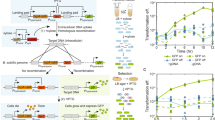Abstract
UNLIKE the wide variation of DNA base composition found in bacteria, higher organisms tend to have a restricted average base composition, (vertebrates ∼ 42 moles per cent guanine + cytosine)1. Thus physical methods such as thermal denaturation or equilibrium density gradient sedimentation, which are useful in distinguishing bacterial DNAs2, do not discriminate to any extent among vertebrate DNAs, excluding the question of satellite bands. Phylogenetic relationships among bacteria, based on other criteria, are largely borne out by DNA–DNA hybridization3. While the latter technique can discriminate among distantly related higher organisms4 it can be applied with only limited confidence to more closely related vertebrates.
This is a preview of subscription content, access via your institution
Access options
Subscribe to this journal
Receive 51 print issues and online access
$199.00 per year
only $3.90 per issue
Buy this article
- Purchase on SpringerLink
- Instant access to full article PDF
Prices may be subject to local taxes which are calculated during checkout
Similar content being viewed by others
References
Sueoka, N., in Evolution of Macromolecules (edit. by Bryson, V., and Vogel, H. J.), 479 (Academic Press, 1965).
Sueoka, N., J. Mol. Biol., 3, 31 (1961).
Marmur, J., Falkow, S., and Mandel, M., Ann. Rev. Microbiol., 17, 329 (1963).
Hoyer, B. H., McCarthy, B. J., and Bolton, E. T., Science, 144, 959 (1964).
Kidson, C., and Kirby, K. S., Biochim. Biophys. Acta, 76, 624 (1963).
Goldstein, J., Bennett, J. P., and Craig, L. C., Proc. US Nat. Acad. Sci., 51, 119 (1964).
Kidson, C., and Kirby, K. S., Biochim. Biophys. Acta, 91, 627 (1964).
Kidson, C., J. Mol. Biol., 17, 1 (1966).
Kirby, K. S., Biochim. Biophys. Acta, 36, 117 (1959).
Parish, J. H., and Kirby, K. S., Biochim. Biophys. Acta, 129, 554 (1966).
Kirby, K. S., Biochim. Biophys. Acta, 55, 382 (1962).
Lowry, O. H., Rosebrough, N. J., Farr, A. L., and Randall, R. J., J. Biol. Chem., 193, 265 (1951).
Kirby, K. S., in Prog. in Nucleic Acid Res., 3, 1 (1964).
Kirby, K. S., Biochem. J., 96, 266 (1965).
Roger, M., Proc. US Nat. Acad. Sci., 51, 189 (1964).
Hershey, A. D., Burgi, E., and Ingraham, L., Biophys. J., 92, 206 (1962).
Author information
Authors and Affiliations
Rights and permissions
About this article
Cite this article
BALDWIN, J., KIDSON, C. Recognition of DNA Base Sequence Differences among Vertebrates. Nature 217, 1256–1257 (1968). https://doi.org/10.1038/2171256a0
Received:
Issue date:
DOI: https://doi.org/10.1038/2171256a0



